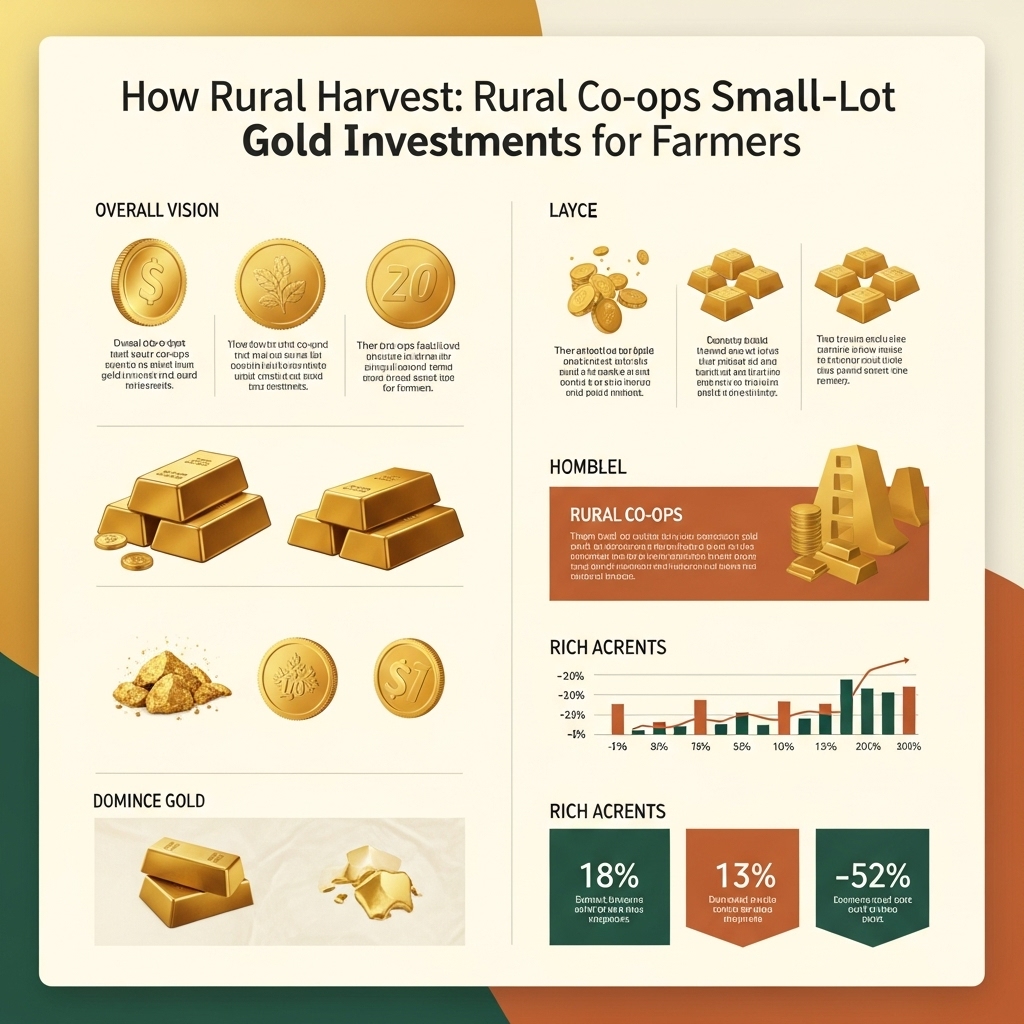Unearthing Opportunity: How Rural Co-ops Democratize Gold Investment
Amidst persistent inflationary pressures and global uncertainties, gold continues to shine as a premier safe-haven asset. Savvy investors are increasingly flocking to the yellow metal for its proven track record in wealth preservation and portfolio diversification. Yet, traditional gold investment avenues, often requiring substantial capital, have remained largely inaccessible for many, especially in rural communities. What if an innovative pathway existed for everyday individuals, particularly farmers, to secure their financial future with gold, even in small increments?
This post will unveil a groundbreaking development: how rural cooperative associations are democratizing gold ownership by offering small-lot investment opportunities to their farmer members. We’ll explore the ingenious mechanisms behind these programs, detailing how they streamline physical gold acquisition without the typical high barriers of bullion purchases or specialized vehicles.
For gold investors, understanding this trend is paramount. It broadens gold’s investor base, making it a tangible asset for wealth protection against economic downturns and currency devaluation, particularly for a demographic often underserved by mainstream financial services. By offering a secure, accessible, and community-backed method for accumulating gold, rural co-ops facilitate not just smart financial planning, but empower farmers to build resilient portfolios, harness gold’s long-term appreciation, and secure their economic stability.
Gold Market Analysis and Key Insights
The burgeoning interest in gold within rural co-ops highlights its enduring appeal as a tangible asset, particularly for farmers seeking wealth preservation and portfolio diversification in an unpredictable economic landscape.
Key Market Insights
Gold has historically served as a reliable safe-haven asset, performing strongly during periods of economic instability, inflation, or geopolitical tension. For farmers whose livelihoods are tied to volatile agricultural commodity markets and land values, gold offers a crucial counter-balance, reducing overall portfolio risk. Its inverse relationship with some traditional assets makes it an excellent diversifier, not directly correlated with crop yields or livestock prices. This fundamental role in wealth preservation underscores its long-term strategic value.
Current Gold Market Trends and Data
Currently, gold prices have demonstrated robust performance, frequently hovering near all-time highs. This strength is underpinned by persistent inflation concerns, ongoing geopolitical uncertainties, and central banks’ continued accumulation of gold reserves. While interest rate hikes by central banks can introduce short-term headwinds, the underlying demand from investors and central banks suggests a bullish long-term outlook. Data indicates significant institutional and retail interest, reinforcing its status as a preferred store of value.
Investment Benefits and Considerations
Investing in small-lot gold through co-ops offers several advantages. It provides an accessible inflation hedge, protects purchasing power, and offers a liquid asset, albeit within the co-op’s framework. The primary consideration is that gold does not yield dividends or interest, unlike other investments. Farmers must also understand the co-op’s specific terms regarding storage fees, premiums on small purchases, and buy-back policies, which directly impact the net return.
Expert Recommendations
Experts generally recommend allocating a modest portion (typically 5-10%) of an investment portfolio to gold as a long-term strategic asset for diversification. For small-lot investors, dollar-cost averaging can mitigate price volatility and optimize entry points. It’s crucial for farmers to view gold as a wealth preservation tool rather than a speculative short-term gain, aligning with the co-op’s mission to provide stable, accessible investment opportunities.

Gold Investment Strategies and Options
Rural co-ops unlock direct physical gold ownership for farmers, overcoming traditional barriers to entry. The primary investment option is small-lot physical bullion (coins, bars), offering tangible wealth preservation. A cornerstone strategy is dollar-cost averaging, investing a fixed amount regularly regardless of price fluctuations. This approach mitigates volatility and builds a position steadily, aligning well with fluctuating agricultural incomes.
Gold acts as a crucial diversifier and inflation hedge, protecting against economic uncertainty. For risk assessment and portfolio allocation, while gold prices can be volatile, its low correlation with traditional assets like stocks or real estate (including farmland) enhances overall portfolio stability. Gold should typically constitute a modest portion, often 5-15% of total investable assets, serving as a defensive allocation rather than a primary growth engine.
Comparing investment methods, direct physical ownership through co-ops offers true asset backing, eliminating counterparty risk associated with paper gold options like ETFs or mining stocks. The co-op model provides secure, local storage and competitive pricing, superior to navigating large bullion dealers independently for small purchases. For market timing considerations, avoid attempting to ‘time’ the gold market based on short-term price movements. Gold is a long-term store of value; consistent, disciplined accumulation through dollar-cost averaging is far more effective than speculative buying or selling, leveraging gold’s role as a foundational, protective asset.
Market Performance and Outlook
Gold has historically served as a resilient store of value, particularly during periods of economic uncertainty and inflation. Following its surge from under $300/ounce in the early 2000s to record highs exceeding $2,000/ounce, its performance underscores its safe-haven appeal. For rural co-op members, small-lot gold investments provide an accessible hedge against market volatility, democratizing access to this historically strong asset class.
Currently, gold prices are influenced by a complex interplay of factors. While elevated interest rates can temper demand by increasing the opportunity cost of holding non-yielding assets, persistent geopolitical instability, escalating national debts, and lingering inflationary concerns bolster its appeal. Gold has largely maintained strong price levels, navigating a high-rate environment due to robust central bank buying and sustained investor demand for diversification.
Looking ahead, the outlook for gold remains cautiously optimistic. Potential future interest rate cuts would reduce the opportunity cost, likely boosting investment demand. Ongoing global uncertainties, combined with the potential for currency debasement and continued de-dollarization trends by some nations, are expected to support gold prices. Economic factors like inflation, real interest rates, dollar strength, and geopolitical risk will continue to dictate its trajectory, with gold acting as a crucial portfolio stabilizer for farmers seeking long-term wealth preservation.
Frequently Asked Questions About Gold Investment
What defines small-lot gold investment through co-ops?
This refers to purchasing physical gold in fractional units (e.g., grams or smaller denominations of troy ounces) rather than traditional large bars. Rural co-ops pool members’ funds to buy in bulk, then allocate these smaller, more affordable portions to individual farmer members.
How is the gold secured, and is it physically held?
Yes, the gold is typically physical and held in secure, insured vaults by trusted third-party custodians or the co-op itself. Members receive digital confirmations or certificates of ownership representing their allocated portion, without needing to store it themselves.
What are the typical costs or fees involved for farmers?
Costs generally include a small premium over the spot price of gold, covering sourcing, secure storage, and administrative fees. Co-ops aim to keep these lower than traditional retail channels due to their collective buying power and non-profit focus, emphasizing transparency.
Can I easily sell my gold investment back to the co-op?
Most co-op programs offer a convenient buy-back option, providing liquidity for farmers. You can typically sell your fractional holdings back to the co-op at or near the current market price, simplifying the divestment process when you need access to funds.
Why is this investment particularly beneficial for farmers?
It offers farmers a tangible, inflation-hedging asset that diversifies their portfolio beyond agricultural assets. It provides a secure store of value, easily accessible and managed through a trusted local entity, helping to mitigate financial risks inherent in farming.

Final Thoughts on Gold Investment
Rural co-ops are truly revolutionizing gold ownership, transforming a historically inaccessible asset into a viable investment for farmers and, by extension, any small-lot investor. The key takeaway is that physical gold can now be accumulated incrementally, providing a robust hedge against inflation and economic volatility directly within trusted community frameworks. This localized approach offers unparalleled convenience and builds confidence for those new to gold.
For savvy investors, this model represents an exciting and accessible avenue to diversify your portfolio with tangible assets, mitigating risk through a potentially more secure channel. We highly recommend exploring this innovative approach. Don’t miss out on this unique opportunity to build wealth and secure your future. Contact your local agricultural co-op today to inquire about their small-lot gold investment programs, and begin your journey towards a more diversified and resilient financial portfolio.